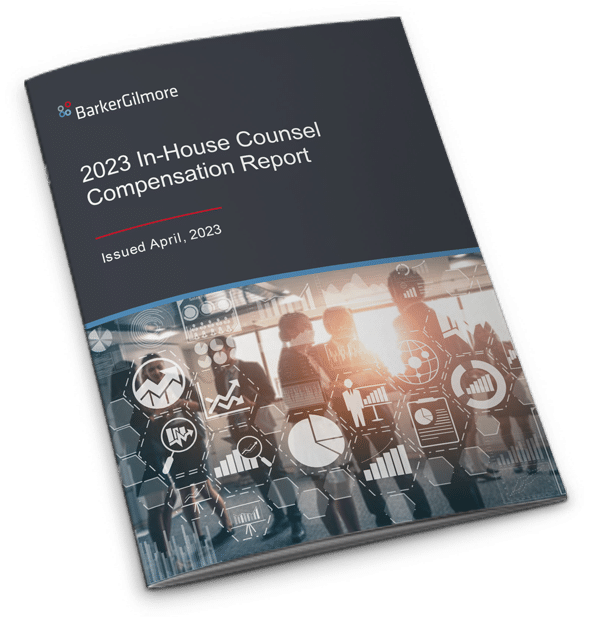Introduction
BarkerGilmore is pleased to present the 2018 In-House Counsel Compensation Report.
The annual In-House Counsel Compensation Report is a highly valued piece for attorneys at all levels looking to benchmark their compensation against that of their peers. It is also sought after by in-house legal and human resources departments seeking to attract and retain the talent necessary to build the most efficient and effective law departments.
Within the last year, uncovering compensation information has become increasingly difficult as states and cities across the country began passing legislation that bans employers from questioning potential hires on salary history. States like California and Massachusetts have already approved the legislation, along with New York City, Philadelphia, and other major cities. The purpose of these new restrictions is to eliminate the gender pay gap existing in the U.S. today. This year’s compensation data indicates that in-house counsel experience this disparity, with female in-house counsel earning about 84% of their male counterparts. While the percentage varies slightly by position level, the overall size of the disparity lines up closely with national averages.
Though compensation inquiry regulations present a viable effort to reduce wage discrimination, it has become more difficult for in-house teams to create compelling compensation packages for candidates. Human Resources teams have historically vetted the current compensation of potential hires to, at the very least, construct an employment offer attractive enough to close the candidate. Without the capability to do so, closing the finalist candidate has become riskier and much less certain.
The 2018 In-House Counsel Compensation Report attempts to help bridge this newfound barrier to communication by providing employers and candidates alike with an industry benchmark to consider while negotiating the final offer.
BarkerGilmore acknowledges the importance of compensation breakdown for companies and their human resources departments to formulate pay strategies, and for lawyers looking to expand their roles or leverage experience for new positions. While this report aims to provide a comprehensive breakdown of legal department compensation structures, we must advise that there are several additional variables that must always be considered when dealing with compensation figures. These variables include an individual’s unique experiences, abilities, and interpersonal skills, as well as the company’s financial position and the strength of the local economy.
To present the most valuable and reliable data, BarkerGilmore has combined its expertise in executive legal recruitment and consulting with extensive survey data to highlight a diverse array of in-house counsel compensation. The information in this report is meant to provide general guidelines, and while it delivers extremely detailed information, we urge readers to consider the multitude of factors affecting the results and to focus on overall data trends displayed in the graphs and charts.
Key Compensation Trends
- Annual Salary Increase Rates: The median annual salary increase rate for all positions across industries dipped to 3.8%, down 0.5% from the previous year, with the life sciences sector experiencing the highest median increase rate of 5.2% from 2016 to 2017. Financial, Energy, and Industrial & Manufacturing industries experienced base increases in line with the previous year, while Consumer, Healthcare, Technology and Professional services saw smaller increases overall.
- Peer Comparison: 41%1 of all respondents believe their compensation is below or significantly below that of their peers in other organizations, with labor & employment lawyers and litigators reporting the greatest dissatisfaction. Those in the energy and banking/finance practice areas express the highest levels of satisfaction with over 24% reporting compensation above or significantly above average.
- Who’s on the Market: 41%2 of respondents indicate that they would consider a new position within the next year due to compensation issues. Those in the consumer industry report the greatest likelihood of a job search in the next year3, while those in the energy industry are the least likely to engage in a job search4. This trend is particularly interesting, because last years’ report showed energy industry counsel as the most likely to engage in a job search. This year, in-house counsel with practice area concentrations in intellectual property, labor and employment, and litigation are most likely to consider a move for compensation issues5, while those who identify with a generalist practice area report least likely to move6. Again, this trend is notable since last year’s report showed generalists as most likely to engage in a job search.
- Public vs. Private: At the General Counsel level, a statistically significant difference exists between the compensation of those at publicly-traded companies and those at private companies. The size of this gap decreases as position level decreases; smaller disparities exist at the Managing Counsel and Senior Counsel levels. The Long Term Incentive (LTI) compensation component poses the greatest disparity across all position levels; LTI is much higher for public-company employees and sometimes non-existent for private-company employees. A gap in LTI between General Counsel and lower level in-house counsel within public organizations accounts for the larger pay gap between GCs and the other law department lawyers than in private companies.
- Gender Pay Trends: On average, female in-house counsel earn 84% of what male in-house counsel earn. The gap is much larger at the General Counsel level, with a 78% disparity, than at Managing Counsel or Senior Counsel levels, which show 90% and 89% disparities respectively. Despite the disparity in total compensation, in 2018, female in-house counsel experienced a base pay increase equivalent to that of male in-house counsel, 3.8%.
- Industry Highs & Lows: The following chart summarizes the highest and lowest paying industries for each position (based on total compensation):
| Position | Public | Private |
| Highest Paying | ||
| General Counsel | Industrial & Manufacturing | Financial |
| Managing Counsel | Energy | Financial |
| Senior Counsel | Life Sciences | Energy |
| Lowest Paying | ||
| General Counsel | Professional Services | Professional Services |
| Managing Counsel | Professional Services | Healthcare |
| Senior Counsel | Professional Services | Professional Services |
Survey Design
BarkerGilmore conducted an online survey from February to April 2018 to assess in-house counsel compensation trends for the year of 2017. The 18-question online survey was administered to a random sample of in-house counsel at various levels of seniority within different sized public and private organizations across the United States. The following table presents the data categories captured by the survey through a combination of closed- and open-ended questions answered by 1,701 individuals from an assortment of different industries and practice areas.
Table 1: Key Survey Terms
| Term | Description |
| Position | General Counsel – the lead in-house lawyer in a company
Managing Counsel – an in-house lawyer with at least one direct report, who is not the lead lawyer in a company Senior Counsel – an in-house lawyer who is an individual contributor |
| Number of Direct Reports | Total number of lawyers managed |
| JD Year | Year in which Juris Doctor was earned |
| Base Salary | Current base salary |
| Cash Bonus | Most recent cash bonus |
| Long Term Incentive | Value of most recent long term incentive award |
| Total Compensation | The sum of the current base salary, most recent cash bonus, and estimated long term incentive value |
| Salary Increase Rate | Percent increase in base salary from 2016 to 2017 |
| Practice Area | Field of specialization within a company |
| Industry | Commercial segment in which the company is situated |
| Company Revenue | Annual company revenue |
| Company Type | Determination of company status: publicly-traded, private, or non-profit |
| Company Location Identity | Type of location in which the company is situated: major metropolitan/large city area, mid-sized metropolitan/city area, or small city/rural area |
| Comparison of Compensation to Peers | How respondents feel their compensation compares to that of their peers at other organizations |
| Likelihood of Compensation-Motivated Job Search | Likelihood respondents will be looking for a new position over the next year due to compensation issues |
BarkerGilmore takes protecting the privacy of those who participated in our compensation survey seriously, since confidentiality is the cornerstone of our business. The information provided by survey respondents has not and will not be shared with anyone.
Data Methods & Analysis
Measure of Central Tendency
This report utilizes median as the main method of standardization for the sample statistics collected from the 2018 Compensation Survey. The median can be described as the middle or central value in a given sequence of numbers. In an even set of numbers, the median is calculated as the average of the two middle numbers. This survey report applies median calculation for all numeric data reported.
Missing Data
While our survey data are nearly complete, we acknowledge the data that are missing due to non-response or misinterpretation. Some respondents opted out of answering a specific question, while others provided unsuitable answers to questions. Since very few cases of missing data occurred, we chose to employ list-wise deletion on a question-by-question basis to eliminate incomplete or inappropriate responses.
Position Breakdown
This report contains data from three distinct classes of in-house counsel7: General Counsel, Managing Counsel, and Senior Counsel. These three classes are largely determined by seniority, experience, and management level, causing compensation to vary across position. Therefore, the greater part of this report is dedicated to the analysis of compensation trends for each individual position.
Prominent Determinants of Compensation
After extensive statistical analysis of the survey data, company type, company revenue, industry, and gender appear to impact compensation significantly for all three positions. JD year and practice area influence compensation for both Managing Counsel and Senior Counsel, but not for General Counsel. Therefore, the following analysis breaks down compensation by company type, company revenue, industry, and gender for all three positions and highlights JD year and practice area breakdown for Managing Counsel and Senior Counsel.
Data Validation
To validate the data used for this report, we compared the median survey data to the median compensation information entered into BarkerGilmore’s contact database from January 2017 to April 2018. In a comparison of base salary for Senior Counsel and Managing Counsel, the survey data and database data are compatible with differences of $5,000 and $16,500 respectively. In a comparison of total cash compensation for General Counsel, the survey data and database data are compatible with a difference of only $25,000. These minute differences are not statistically significantly different from zero, meaning that the survey data display a high level of validity.
Disclaimer of Approximation
The data displayed in this report were collected from a wide variety of in-house counsel whose compensation figures are highly dependent on a multitude of different intervening variables. For the purpose of simple interpretation, the complex statistical relationships that resulted from these variables are not included in this report. Thus, the proceeding trends should be considered approximations of compensation data that are ultimately contingent upon numerous influences taken together.
Survey Response Breakdown
*This section displays response rate and general characteristics of the survey respondents
Collective In-House Compensation Trends
General Counsel Compensation Trends
Managing Counsel Compensation Trends
Senior Counsel Compensation Trends
About BarkerGilmore
BarkerGilmore is a boutique firm of distinguished consultants who are recognized by CEOs, boards, and corporate legal and compliance leaders as best-in-class executive search consultants, advisors, and coaches. Our niche concentration affords us access to a specialized network of talent, and we have established relationships that allow us to identify the best legal and compliance professionals for any assignment. We are attentive to each of our client’s business culture and understand their brand, strategy, and leadership needs. We pride ourselves on being able to provide the highest standard of service and on establishing meaningful and long-lasting relationships with our clients.
(877) 571-5047
www.barkergilmore.com
1 Down 2% from the previous year
2 Consistent with the previous year
3 47% with a high or very high probability
4 65% with low or very low probability
5 46% with a high or very high probability
6 65% with a low or very low probability
7 Refer to Table 1 for a detailed description of the three position classifications for in-house counsel.
Connect with a legal recruiting advisor
* indicates required fields


































